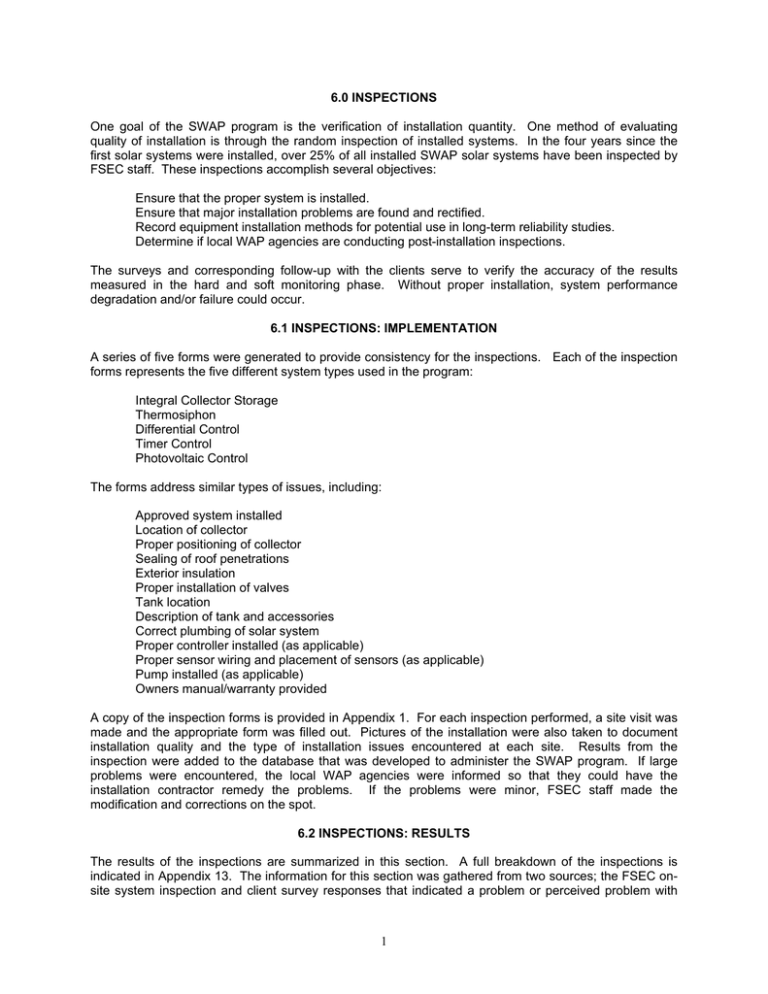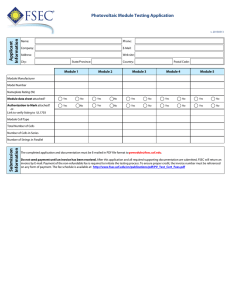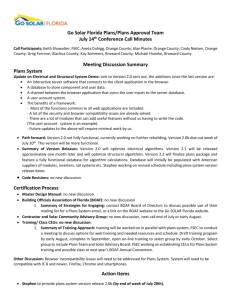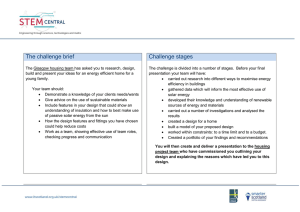6.0 INSPECTIONS
advertisement

6.0 INSPECTIONS One goal of the SWAP program is the verification of installation quantity. One method of evaluating quality of installation is through the random inspection of installed systems. In the four years since the first solar systems were installed, over 25% of all installed SWAP solar systems have been inspected by FSEC staff. These inspections accomplish several objectives: Ensure that the proper system is installed. Ensure that major installation problems are found and rectified. Record equipment installation methods for potential use in long-term reliability studies. Determine if local WAP agencies are conducting post-installation inspections. The surveys and corresponding follow-up with the clients serve to verify the accuracy of the results measured in the hard and soft monitoring phase. Without proper installation, system performance degradation and/or failure could occur. 6.1 INSPECTIONS: IMPLEMENTATION A series of five forms were generated to provide consistency for the inspections. Each of the inspection forms represents the five different system types used in the program: Integral Collector Storage Thermosiphon Differential Control Timer Control Photovoltaic Control The forms address similar types of issues, including: Approved system installed Location of collector Proper positioning of collector Sealing of roof penetrations Exterior insulation Proper installation of valves Tank location Description of tank and accessories Correct plumbing of solar system Proper controller installed (as applicable) Proper sensor wiring and placement of sensors (as applicable) Pump installed (as applicable) Owners manual/warranty provided A copy of the inspection forms is provided in Appendix 1. For each inspection performed, a site visit was made and the appropriate form was filled out. Pictures of the installation were also taken to document installation quality and the type of installation issues encountered at each site. Results from the inspection were added to the database that was developed to administer the SWAP program. If large problems were encountered, the local WAP agencies were informed so that they could have the installation contractor remedy the problems. If the problems were minor, FSEC staff made the modification and corrections on the spot. 6.2 INSPECTIONS: RESULTS The results of the inspections are summarized in this section. A full breakdown of the inspections is indicated in Appendix 13. The information for this section was gathered from two sources; the FSEC onsite system inspection and client survey responses that indicated a problem or perceived problem with 1 their solar system. Problems noted during FSEC inspections and those reported through client surveys were listed in the FSEC SWAP database under problem events. This section of the report deals with the problem events. All of these problem events are presented in this section, rather than the survey section. As Table 6.2-1 indicates, many of the problems are not significant enough to cause system failure, although they may eventually lead to lower performing systems. However, most of these problems could have been resolved with little additional effort at the time of installation. Of the problems indicated, 53% are solar installation related. All other problems are due to monitoring activities, electrical system, and plumbing. These discrepancies also include not providing clients with system owner’s manuals and warranty documentation. Additionally, there appear to be many types of problems. No single major problem was found. It is quite obvious from the problems and minor discrepancies discovered by FSEC during their inspections that many of the local WAP agencies were not conducting adequate post-installation inspections of the installed systems. Table 6.2-1. The Eleven Most Common Identified Problems Problem No problem exists Problem not determined* Exterior piping not UV protected Piping insulation not well sealed Hot/cold piping not insulated properly Reverse thermosiphoning through anti-scald valve Air in system after ICS installed Plumbing leak Sensor wires not protected from environment No hot water (Actually a symptom) Hot water temperature is too low (A symptom) * Information obtained from client surveys. Magnitude of Problem N/A Varies Minor Minor Minor Minor Minor (Self correcting) Moderate-Major Moderate Major Moderate % of Problem Events 29 5 5 5 4 4 3 3 3 3 3 The means of identifying problems is also useful to know. The collected data indicate that the inspections were the most effective in identifying problems. The major problem identification means is shown in Table 6.2-2. Table 6.2-2. The four most common problem identification methods Problem identification Routine inspection Homeowner Survey Monitoring (only 4% of systems monitored) Homeowner observation % of Problems 70 10 8 8 Table 6.2-3. provides a breakdown of the problem types. Installation errors account for the largest number of problems. No problem found was the second largest category. Note that some of the problems listed above (e.g. ICS air entrainment) are not classified as problems in this section because they are not true problems with the product and/or installation (the air leaves the ICS on its own). There is clearly a wide disparity in the quality of work done by installers. Although any installer is likely to have a few problem installations, some installers had an installation problem rate (real problems) of up to 88% (17 installations). A guideline of minimal quality (e.g., 10% problem rate or less) should be used for minimum installer quality. 2 Table 6.2-3. Most Common Problem Types Problem Type % of Problems Installation 36 No problem * 33 Device failure 8 Other 7 Adjustment 5 Design 4 * FSEC inspection conducted after client problem event notification on survey. No problems discovered. As indicated in Table 6.2-3., product failures only constitute 8% of the total problems. After only 2-3 years, this is not expected to be a big problem. Table 6.2-4. indicates the failures observed to date. Note that many of the failures have not been fully documented. Table 6.2-4. Primary Product Failures (Year 2-3) Product Failure % of Product Failures Corrected (undocumented)* 31 Unresolved (undocumented)** 21 Replaced Air Vent 10 Replaced freeze valve 7 Replaced check valve 7 * Client surveys indicated problem had occurred but was eventually corrected. ** Information obtained from client surveys. Identifying a problem is the first step in getting the system operational. Common symptoms are shown in Table 6.2-5. Note that the largest symptom is that the system appears to be operating. This underscores the fact that many of the problems that have been encountered are minor. Table 6.2-5. Common Problem Symptoms Symptom % of Problem Symptoms Appears to be working (minor/no problems)* 62 Plumbing leaks 6 No hot water 4 Can’t tell if system is working (From surveys) 4 High cold water inlet temperatures (Monitoring) 4 Not enough hot water 3 * For example: Water dripping from roof in winter turned out to be freeze valve functioning as it should, etc. Resolution is the key step to maintaining system operation and persistence of savings. Table 6.2-6. indicates the primary means of problem resolution. Many of these have not been fully documented and/or have not been resolved at this point. Note that many of the problems are either not problems (see previous tables) or are not serious enough to require attention. 3 Table 6.2-6. Problem Resolution Problem Resolution % of Problem to be Resolved No action required 30 Not resolved yet 22 Corrected (undocumented)* 16 No clear resolution 5 Raise thermostat temperature 4 Add check valve to anti-scald valve loop 4 * Client surveys indicated problem had occurred but was eventually corrected. 6.3 INSPECTIONS: VISUAL SITE INSPECTIONS The primary purpose of the system inspection process was to make sure that the systems were installed and operating properly and also to characterize the type of installation and system problems encountered. Note that the local agencies’ inspection information and data (if inspected) were not included in the final inspection results. FSEC staff were nevertheless, often contacted by local agencies when they conducted a system inspection and needed technical input or assistance in clarifying or resolving noted problems. FSEC routinely inspected systems after initial installation. Since FSEC received installed system report forms (which did not include inspection information, only the status and information on the systems installed) for each system installed by all agencies, FSEC could eventually conduct spot inspections to make sure that the systems were properly installed and that the local agencies were indeed conducting satisfactory inspections. The majority of inspections were conducted by FSEC during the installation phase of the program. After all systems had been installed, FSEC sent system owner surveys to all clients that had received solar systems. (Please refer to Section 7.0 for a detailed summary of the survey findings.) Several of the clients noted that they had or were having problems with either the solar system, its components, or hot water delivery. At that time, FSEC conducted visits to these sites to investigate the problems. The results of these extra inspections are also included in this study. FSEC inspected 210 (26% of total installed) solar systems during the SWAP program. This does not include sites that were inspected during the solar site selection process. FSEC staff became quite familiar with low-cost system installations. The following tables provide information on the total number of systems inspected by geographic location as well as by system type. Installing solar systems requires much attention to detail. In addition, the installation is usually conducted in less than ideal conditions; on roof tops, in extremely hot attics, and in cramped utility rooms and garages. Because of this, shortcuts and lack of attention to details may occur. Although these do not in general, affect the operation of the system in a major way, they can, in the long run, lead to performance and materials problems that could require that the system be serviced. Installers have to solder pipes, valves, fittings, pumps, and ancillary plumbing materials. Also, they have to install solar collectors on roofs, which includes making roof penetrations and installing of roof flashing. Electrical work is usually centered around installing controllers and necessary sensor wiring, as well as, at times, having to replace electric water heaters. It must be noted that although other licensed trades, such as plumbers, and HVAC contractors, are allowed to install solar systems, they very often do not have the overlapping required skills. For this reason, FSEC provides solar water heating system training programs to increase the level of expertise and knowledge required to install solar systems. 4 Figure 6.3-1 FSEC staff conducting solar system training. Solar systems are not purchased in modular forms. Various household appliances come, in most part, as pre-assembled units. This is not the case with solar systems. Most components come separately and have to be installed in the field. This includes the mounting of solar collectors, the plumbing of numerous valves and pumps, the installation of insulation on water piping, the coating of exterior piping to protect it from ultraviolet rays and so forth. Each component must be installed in a particular way to ensure proper system operation and long term reliability. In conducting the inspections, FSEC was very concerned about identifying not only extreme system problems, such as defective controllers and/or sensors, but also small negligible problems and shortcuts taken that led to less than ideal system installations. Figure 6.3-3. Working in restricted areas. Figure 6.3-2. Installing plumbing and insulation in attic. 5 Table 6.3-1. SWAP System Inspections by Location Location North Florida Central Florida South Florida Number of inspections 38 82 90 % of total installed systems (in location) 21 37 23 Table 6.3-2. SWAP Systems Inspected by System Type System Type Active (Pumped) Flat-plate Integral Collector Storage (ICS) Thermosiphon Number of systems 115 93 2 Percent of total inspected systems (by system type) 14 12 .03 The majority of discrepancies noted during inspections were of a manner that did not directly affect system performance. Discrepancies were related more to craftsmanship than major system design or material flaws. Following is a photographic overview of some of the most common inspection discrepancies noted. Each discrepancy will be accompanied by a photograph of a separate installation indicating the proper installation method. The following pictorial descriptions highlight a variety of discrepancies that were encountered during the inspection of SWAP systems by FSEC staff. This does not include all discrepancies noted, but primarily the major ones and those that were too often repeated. Illustrated is both a problem situation as well as an example of the proper way of conducting the installation task. COLLECTOR SHADING Figure 6.3-4a. Collector is shaded during much of the day. Figure 6.3-4b. Unshaded collector provides solar gain throughout the day. 6 COLLECTOR AND EXTERIOR PIPE DRAINING Figure 6.3-5a. Collector return line can not be completely drained due to upswing in piping. At times, this is unavoidable due to the layout of the roof and access locations. Figure 6.3-5b. Simple roof layout allows easy roof penetration location. COLLECTOR SECURELY ATTACHED TO MOUNTING HARDWARE Figure 6.3-6a. Simple oversight while installing the collector without hardware Figure 6.3-6b. Properly bolted mounting hardware. 7 ROOF PIPE PENETRATIONS ARE PROPERLY AND AESTHETICALLY SEALED Figure 6.3-7a. Roof flashing is exposed and improperly sealed. Figure 6.3-7b. Roof flashing is well installed. Insulation is added to cover pipe after copper is soldered. EXTERIOR PIPING INSULATION PROTECTED FROM ULTRAVIOLET RAYS Figure 6.3-8a. Sections of insulation and sensor wiring have not been protected from ultraviolet rays. 8 Figure 6.3-8b. Care is taken to make sure that all exposed piping and sensor wires are ultraviolet ray protected Figure 6.3-9a. Cracking and eventual deterioration will occur if insulation is not ultraviolet ray t t d Figure 6.3-9b. Well protected insulation will last many years. Figure 6.3-10b. A very professional and aesthetically pleasing job. Figure 6.3-10a. Plastic-based insulation should not be used for exterior piping. 9 PIPING JOINTS AND ENDS ARE WELL SEALED Figure 6.3-11a. Ends of pipe runs should be well butted. Figure 6.3-11b. Use of 45 degree angle cut and insulation glue provides a positive and aesthetic seal. AIR VENTS INSTALLED IN VERTICAL POSITION Figure 6.3-12b. Air vent installed in true vertical position. Figure 6.3-12a. Air vent installed in plane of collector instead of vertically true north. 10 SENSORS SECURELY ATTACHED AND PROTECTED FROM ENVIRONMENTAL DEGRADATION Figure 6.3-13a. Collector sensor secure but not insulated or protected from environmental degradation. Figure 6.3-13b. Collector sensor is secure and protected from environmental conditions. LOCATION OF COLLECTOR SENSOR Figure 6.3-14a. Collector sensor installed too far from collector. 11 Figure 6.3-14b. Collector sensor securely attached at exit of collector - the hottest point. TANK PIPING INSULATED Figure 6.3-15a. External tank piping not completely insulated from heat losses. Figure 6.3-16a. Little pride of work reflected in this insulation job Figure 6.3-15b. Thorough insulation of tank piping. Figure 6.3-16b. Excellent insulation installation. 12 Figure 6.3-17a. Attic insulation must be secured. Figure 6.3-17b. Attic pipe well insulated and glued together at 45 degree joint. WATER HEATER NOT PROTECTED FROM ELEMENTS Figure 6.3-18a. Top and sides of water heater protected, but not front. Pump is exposed to elements. Figure 6.3-18b. Water heater and components enclosed in storage shed. 13 Figure 6.3-19a. System controller protected by common Tupperware enclosure. Figure 6.3-19b. Solar pump and controller are protected. Figure 6.3-20b. Protected water heater and solar components. Figure 6.3-20a. Minimal water heater and component protection. 14 BASIC WORKMANSHIP Figure 6.3-21a. Ceiling penetration left bare. Figure 6.3-21b. Escutcheons used to cover ceiling penetrations. Figure 6.3-22a.. Extra sensor wiring left dangling on floor. Figure 6.3-22b. Neat solar plumbing and insulation installation to water heater. 15 6.4 LIFETIME OF SOLAR SYSTEMS The anticipated useful lifetime of the SWAP systems is expected to be at least 20 years. The ICS systems could possibly have the longest periods without any service interaction due to their simplicity and lack of major mechanical parts. This of course, will depend on the reliability of the various valves and ancillary plumbing material. Figure 6.4-1. From left, freeze prevention valve, air vent, and pressure relief valve installed on a flat-plate collector system. Flat-plate solar collectors also have a twenty-year (minimum) life expectancy. The servicing of various pumps, valves, etc., will undoubtedly occur during this lifetime. FSEC is hoping to continue long term evaluation of the SWAP systems to accurately determine the operational lifetimes and maintenance costs of the various components. During the implementation phases of this program, FSEC queried major industry representatives in Florida to develop a general idea of the expected lifetime of the various components used in solar water heating systems. Six major Florida manufacturers and installers provided this information. This survey was conducted in 1993. Table 6.4-1 outlines the components and their expected lifetimes. The figures listed are averages. The averages by category refer to general collectors, pumps, controllers, etc. Table 6.4-1. Average Component Lifetimes SYSTEM COMPONENT HIGH AND LOW RESPONSES AVERAGE LIFETIME BY CATEGORY Flat-plate collector Integral Collector Storage Collector AVERAGE EXPECTED LIFETIME (YEARS) 29.0 23.0 15 to 40 9 to 30 26.0 Pump, DC Pump, AC 9.8 12.0 7 to 15 10 to 15 10.9 Storage tank, solar Storage tank, conventional electric 9.4 9.4 5 to 15 5 to 15 9.4 Controller, differential Controller, photovoltaic 8.9 14.4 4 to 13 10 to 20 16 Controller, timer 9.5 8 to 10 10.1 Freeze prevention valve Air vent Pressure-Temperature relief valve Pressure relief valve Vacuum breaker Isolation valve, gate Isolation valve, ball Drain valve Check valve, vertical Check valve, horizontal Check valve, motorized 4.3 5.5 9.0 11.6 7.1 5.6 13.0 14.7 5.9 5.1 8.6 3 to 5 3 to 8 7 to 10 8 to 20 3 to 15 2 to 10 10 to 15 7 to 20 2 to 10 2 to 10 5 to 10 8.2 Piping, copper 20+ 20+ 20+ Note that these figures are based on verbal interviews with the respondents. There is a wide range reported for similar components. The actual lifetime of specific components, especially the valves, is highly debatable. Also, the brand of components and quality of installation would greatly affect the lifetime of the component. Quality components installed properly have long lifetimes. Local water quality also greatly affects the degradation of components as has been exhibited in the SWAP program. (See Overview of the Installed Systems – Section 2.0) Funds permitting, FSEC will maintain contact with the SWAP clients and maintain its database to obtain field information on the reliability and lifetime of the SWAP systems and their components. This is a golden opportunity to validate component reliability and lifetime information. 17 18




